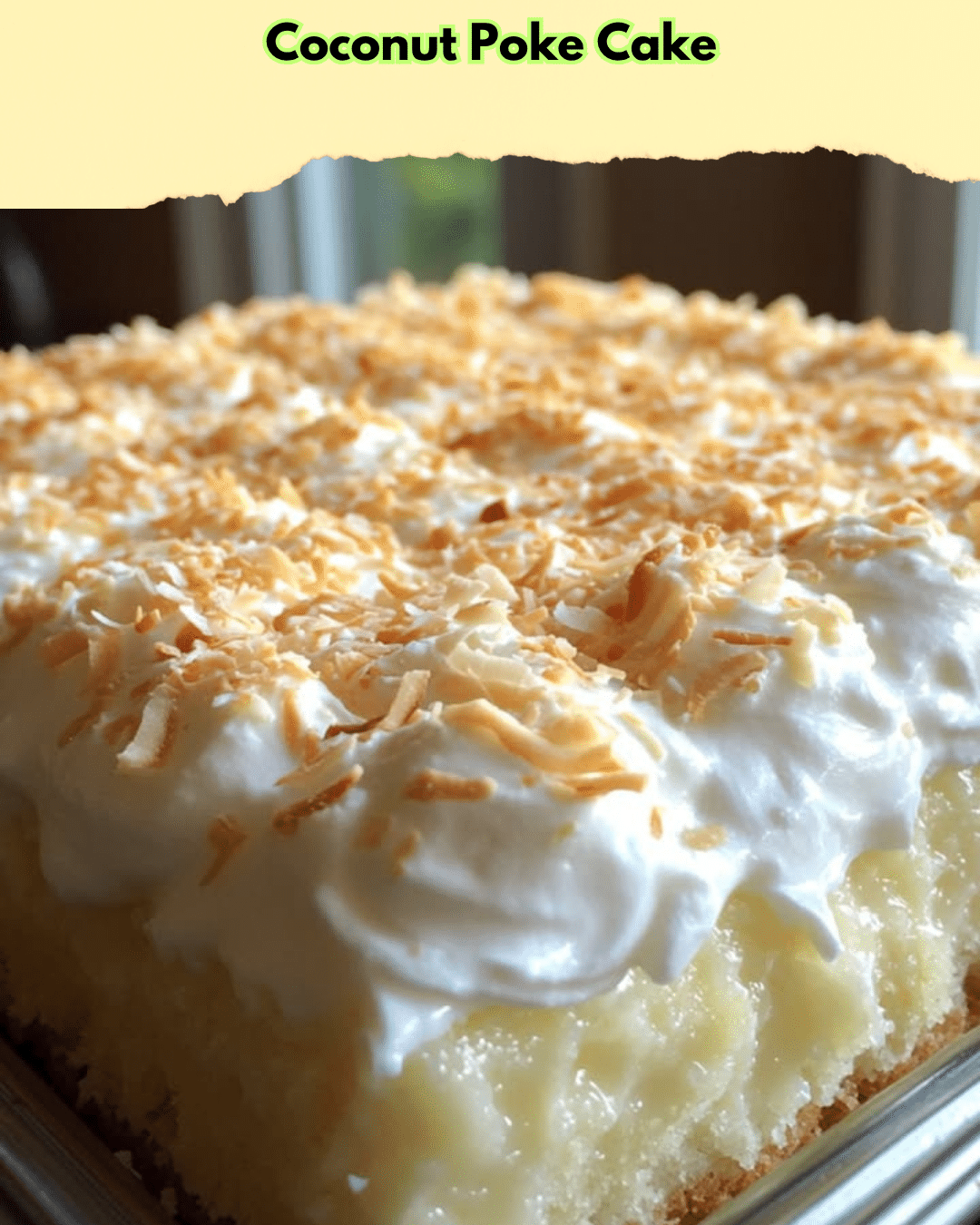Coconut Poke Cake: A Tropical Delight for Every Occasion
Indulge in the tropical flavors of this delectable Coconut Poke Cake. With every bite, experience the sweet symphony of moist coconut-infused cake, perfectly complemented by a luscious cream topping. The Coconut Poke Cake is designed for versatility, making it your go-to dessert for festive events or a simple family gathering. Crafted with minimal effort but bursting with flavor, this cake promises to transport your taste buds straight to a tropical paradise.
Quick Recipe Highlights
- Flavor Profile: The Coconut Poke Cake offers a harmonious blend of sweet coconut and creamy vanilla, with a hint of tropical zest that enlivens each bite.
- Texture: Experience an incredibly moist cake thanks to the infused coconut milk, layered with a silky smooth creamy topping that melts in the mouth.
- Aroma: The cake emanates a rich coconut aroma, reminiscent of a gentle island breeze.
- Visual Appeal: This cake dazzles with its pure white coconut flakes against a creamy backdrop, creating an inviting and sophisticated dessert.
- Skill Level Needed: Beginners will find this recipe manageable, given its straightforward steps and reliance on a boxed cake mix foundation.
- Special Equipment: You’ll need a hand mixer and a poking tool, such as a fork or a skewer, to achieve the signature texture of the poke cake.
Recipe Overview
- Difficulty Level: The Coconut Poke Cake is classified as easy due to its simple instructions and common ingredients, perfect for novice bakers or those short on time.
- Category: As a classic dessert category, this coconut cake fits well into celebrations, potlucks, and as an everyday sweet treat.
- Cuisine: While cake is globally recognized, the addition of coconut gives this version a distinctly tropical flair.
- Cost: With ingredients mostly from a typical pantry and a modest outlay for coconut milk, this cake is affordable yet extravagant in taste.
- Season: Ideal for summertime, this cake’s light and refreshing quality is perfect for warm weather dining, although it can bring warmth to any season’s table.
- Occasion: Suitable for both casual and formal events, offer it at birthdays, picnics, or family Sunday dinners.
Why You’ll Love This Recipe
The Coconut Poke Cake offers an irresistible combination of sweet flavors and soft textures that cater to dessert lovers everywhere. Its creamy finish and moist layers keep each bite delectable. Preparation convenience makes it accessible— the recipe is straightforward, with no complicated baking techniques or hard-to-find ingredients, making it perfect for a spontaneous bake or planned events.
Nutritionally, the Coconut Poke Cake provides a lighter calorie alternative to richer chocolate desserts, making it a delightful choice for those monitoring their sweet intake. It also provides an excellent opportunity to entertain guests, with its exotic flavors sparking interesting culinary conversations. Lastly, this cake is cost-effective; it uses simple, affordable ingredients that most households have on hand, ensuring this tropical treat is within reach anytime.
Historical Background and Cultural Significance
The origin of the poke cake technique—where holes are poked into the baked cake to fill with a delicious liquid or syrup—dates back to the mid-20th century, primarily in the United States, as a way to enhance flavor and moisture. This method became a popular baking trend for enhancing and diversifying classic cake recipes.
Coconut, a staple in many tropical regions, holds vast cultural significance as a versatile fruit used in cooking, crafting, and traditional rituals. Over the years, the fusion of coconut with conventional Western cake recipes has led to innovative desserts like the Coconut Poke Cake, which celebrates this rich culinary tradition.
This dessert has evolved to include a variety of fillings and toppings, allowing it to cater to diverse tastes while maintaining its identity as a comforting yet indulgent treat. Regionally, variations are vast—from pina colada-infused layers in the Caribbean to pandan leaf and coconut sugar influences in Southeast Asia, illustrating the recipe’s adaptability across cultures.
Ingredient Deep Dive
Coconut milk is a crucial element in adding richness to the poke cake. It has been treasured in tropical regions for centuries, offering a creamy texture and delicate flavor that elevates sweet and savory dishes alike. Coconut milk is also known for its health benefits, including essential vitamins and minerals like manganese and copper.
When selecting coconut milk for your recipe, opt for brands without added sugars or preservatives to maintain purity. Store unopened cans in a cool, dry place, and refrigerate once opened. If coconut milk is unavailable, cream of coconut or evaporated milk can serve as a substitute, offering a similar consistency with slight flavor variations.
Common Mistakes to Avoid
- Neglecting to poke enough holes in the cake: Fewer holes mean uneven absorption of the coconut milk, resulting in dry spots.
- Overmixing the batter: This can cause a dense cake. Mix just until ingredients are combined.
- Forgetting to allow the cake to cool before poking: A hot cake can crumble when pierced.
- Using sweetened coconut milk by mistake: This can make the cake overly sweet—use unsweetened coconut milk instead.
- Skipping the chilling step: Chilling helps set the cake, making it slice neatly.
- Failing to cover the cake properly: This can lead to dryness if left uncovered in the fridge.
- Not removing lumps in the topping: Use a whisk or mixer to smooth the topping.
- Storing at room temperature for too long: Always refrigerate this cake to maintain its texture and safety.
Essential Techniques
Mastering the poke technique is essential for achieving the perfect Coconut Poke Cake. Poking holes into the cake creates channels for the coconut milk to seep through, ensuring moistness throughout. Use a skewer, fork, or chopstick to create holes while your cake is warm, but not hot. Ensure the holes are evenly spaced and cover the cake surface for even distribution. This technique, when mastered, elevates a basic cake into a specialty dessert.
Pro Tips for Perfect Coconut Poke Cake
Ensure your cake only slightly cools before poking, as warmth aids in better absorption of the coconut milk. Transform the aesthetic of your dessert by topping it with toasted coconut flakes for added texture and flavor. For an extra burst of coconut essence, incorporate coconut extract into your cake mix. Always use room temperature eggs for even texture and to prevent sudden temperature changes that affect cakery rise. When layering the topping, spread smoothly for a clean, professional appearance. For a dessert presentation, add a dollop of whipped cream, which balances the cake’s richness. Lastly, for an irresistible twist, top with shredded white chocolate for visual and culinary sophistication.
Variations and Adaptations
Experiment with regional variations by incorporating local ingredients such as mango puree or passionfruit for an added tropical dimension. Seasonally, swap out the cream topping with fruit compote—a tart cherry or blackberry reduction offers wonderful contrast during winter. For dietary modifications, substitute dairy-based cream with vegan coconut cream and adjust the sugar for vegan sweetness alternatives. Play with flavor by adding lemon zest to introduce citrus freshness. Modify texture by integrating chopped nuts into the cake mix, lending a crunch with every slice. For presentation, layer the cake in a trifle dish to reveal the distinct layers, offering a stunning and modern twist.
Serving and Presentation Guide
Plating for Coconut Poke Cake is an art that emphasizes its visual allure. Serve slices on vibrant plates to contrast the cake’s whites and golds, and use a leaf-shaped dish to evoke its tropical roots. Garnish with edible flowers like violets or orchids to enhance its exotic appeal. Pair traditionally with a simple fruit salad, allowing the cake’s flavors to remain the highlight. Modern serving suggestions include placing individual slices in martini glasses for cocktail parties. Maintain optimal cake integrity by storing and serving chilled, ensuring the topping’s firmness. Lastly, use a serrated knife for clean cuts when portioning.
Wine and Beverage Pairing
Pair your Coconut Poke Cake with a Riesling or a Sauvignon Blanc, as these wines balance sweetness with bright acidity, complementing coconut’s creaminess. Non-alcoholic options include coconut water infused with mint or lime, creating a refreshing palette cleanser. Coffee enthusiasts will find that a light roast coffee heightens the cake’s flavors without overpowering them. When serving beverages, ensure they are moderately chilled to harmonize with the cake’s temperature. Finally, present drinks in elegant, matching glassware to elevate your dining experience.
Storage and Shelf Life
Store the Coconut Poke Cake covered in the fridge, maintaining its moisture and freshness for up to five days. Ensure the container is airtight to prevent fridge odors from altering the cake’s aroma. For longer storage, consider freezing individual slices, tightly wrapped in plastic wrap and placed in a freezer bag, to enjoy within three months. Be vigilant for signs of spoilage, like an off smell or discoloration, and avoid consuming if these are present. Reheat individual slices in the microwave for 20 seconds to restore softness, or allow to thaw naturally in the fridge overnight if frozen.
Make Ahead Strategies
Prepare components like the cake and coconut milk infusion a day in advance, separating preparation time and ensuring all flavors develop overnight. Store the cake base in an airtight container, preferably chilled, to maintain its freshness. Quality remains intact with proper chilling, allowing the flavors to marry effectively. Assemble the final cake, including the topping, an hour before serving, ensuring it’s adequately set. Upon reheating, cover the cake to retain moisture, or serve directly from the fridge for a refreshing cool treat. To enhance appearance or flavor, add fresh berries or mint as a garnish before serving.
Scaling Instructions
Halve the Coconut Poke Cake recipe by reducing ingredients proportionally while maintaining flavor balance. Use smaller baking pans to achieve optimal height and texture. For doubling, use a larger baking dish to prevent overflow and adjust baking time as necessary, ensuring the cake is evenly cooked. Maintain storage guidelines when increasing quantities, as keeping it covered is essential for preserving moisture. For significant batches, consider making two separate cakes to uphold quality. If space is a concern, freeze portions for later enjoyment, ensuring convenience without compromising taste.
Nutritional Deep Dive
The Coconut Poke Cake offers a balanced macro profile, with carbs primarily from coconut milk and cake mix, delivering energy. It provides essential micronutrients from coconut, including lauric acid, which supports immune function. The delicious topping comprises fats from coconut milk and cream, imparting creamy texture while being mindful of dietary fat intake. When portioning, adhere to reasonable slice sizes to manage carbohydrate load and maintain balanced nutrition. Skin and cardiovascular health benefit from cake fats; however, moderation is key for maintaining caloric balance.
Dietary Adaptations
For a gluten-free version, use a gluten-free cake mix without altering the cake’s coconut-rich taste. Dairy-free adaptations include using non-dairy cream options, like almond or cashew cream, to ensure all diners can enjoy. Craft a vegan iteration by omitting eggs and using flaxseed or chia seed replacements, maintaining moisture through incorporation. Low-carb enthusiasts can substitute sugar with erythritol or stevia, minimizing carbohydrates without losing sweetness. Keto adherents may rely on almond flour and coconut flour blends, and Paleo followers can incorporate honey or maple syrup as natural sweeteners, adhering to diet tenets comprehensively.
Troubleshooting Guide
Texture issues like a dense cake can be due to overmixing the batter; avoid mixing beyond ingredient integration. Imbalanced flavors arise with oversweetened toppings—adjust sugar levels to preference. Address undercooked cake centers by ensuring proper oven preheating and use a toothpick test for doneness. Substitute ingredients carefully; if coconut milk is unavailable, use evaporated milk with a splash of coconut extract for authentic taste. With timing concerns, ensure adequate cooling before poking—the cake should be warm yet stable. Neutralize sweetness variations by strategically using citrus or berries.
Recipe Success Stories
Community feedback highlights the Coconut Poke Cake’s adaptability in family settings, with variations suiting individual tastes—from adding pineapple essence for a piña colada vibe to using chocolate shavings for a richer appeal. Reader successes often lean on the cake’s forgiving nature; substitutions and variations yield equally delightful results. Readers suggest experimentation with toppings, adding personal style with whipped cream or fruit decorations. Photography tips include capturing the cake’s glossy surface under natural lighting, enhancing its visual allure. Adaptations, such as substituting sweeteners or flour types, ensure this cake is a stand-in staple for any gathering.
Frequently Asked Questions
Q: Can I make this cake ahead of time?
A: Yes, you can prepare the components in advance and assemble them before serving. Storing assembled cake in the refrigerator overnight allows flavors to meld.
Q: What if I don’t have coconut milk?
A: Substitute with evaporated milk and add a few drops of coconut extract to mimic the flavor, delivering a similar coconut essence.
Q: How do I prevent the cake from becoming too soggy?
A: Poke evenly spaced holes, ensuring they aren’t too large, to control moisture absorption and achieving the desired consistency.
Q: Is it possible to add fruit?
A: Definitely! Layer sliced fruits like mango or berries between cake and topping to enhance flavor and texture, adding a fruity twist.
Q: Can I freeze leftover cake?
A: Yes, wrap individual slices well in plastic and store them in a freezer-safe bag to retain freshness. Thaw in the refrigerator before consuming.
Q: Is this recipe traditional in certain regions?
A: While the poke cake method is primarily American, its adaptation into coconut flavors invokes tropical culinary elements enjoyed globally.
Q: How do I alter the sweetness level?
A: Adjust sugar in the topping or use unsweetened coconut cream for reduced sweetness, tailoring it to personal taste.
Q: What’s the best way to transport this cake?
A: Use a deep container with a snap-on lid to maintain the cake’s structure during travel, keeping it refrigerated until serving.
Q: Are nut substitutions available?
A: For allergy-friendly alternatives, omit nuts or replace them with coconut flakes, ensuring consistency while avoiding allergens.
Q: What if my cake didn’t set properly?
A: Chill longer in the refrigerator before slicing, as adequate cooling time helps define the cake’s layers and consistency.
Q: How can I present this cake elegantly?
A: Serve slices on elegantly designed plates, adding a sprinkle of toasted coconut or edible flowers for visual enhancement.
Additional Resources
Explore related coconut and tropical desserts to expand your repertoire, including pineapple upside-down cake and coconut cream pie. Technique guides on perfecting poke cakes ensure each attempt results in evenly moist outcomes, enriching baking skills. Delve into ingredient history, including coconut’s vast culinary applications, through sourcing sustainable and organic products. Equipment recommendations spotlight essential tools like quality mixing bowls and durable baking trays that round out efficient kitchen operations. Consider seasonal variations, incorporating unique ingredients to innovate with diverse flavors that emphasize versatility in tropical-themed desserts.
Print
Coconut Poke Cake
Description
A moist and flavorful coconut cake infused with creamy coconut milk and topped with whipped cream and shredded coconut.
Ingredients
For the Crust:
- 1 box white cake mix
- 1 can (14 oz) coconut milk
- 1 can (14 oz) sweetened condensed milk
- 1 tub (8 oz) whipped topping
- 1 cup shredded coconut
Instructions
1. Prepare the Crust:
- Prepare the white cake mix as per package instructions and bake in a 9×13 inch pan.
- Once the cake is baked, let it cool slightly and then poke holes all over the cake using a fork.
- Mix the coconut milk and sweetened condensed milk together, pour over the cake, and let it soak in for a few hours or overnight in the fridge.
- Spread the whipped topping over the top of the cake.
- Sprinkle the shredded coconut evenly on top before serving.
Notes
You can customize the seasonings to taste.




